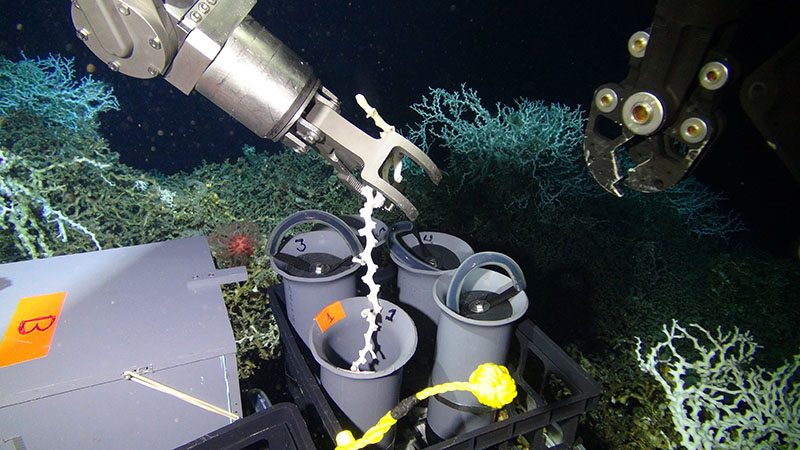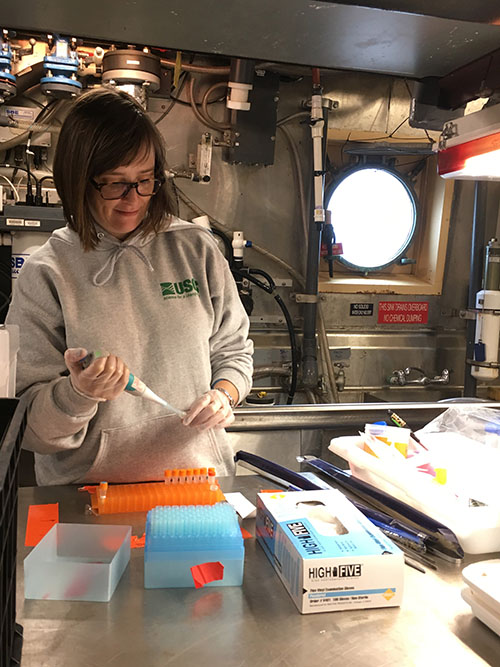
By Katharine Coykendall, United States Geological Survey
August 17, 2017

A robotic arm of the ROV Odysseus, operated by Pelagic Research Services, removing the cap from a sampling quiver in preparation to carry a coral fragment to the surface. Image courtesy of NOAA Southeast Deep Coral Initiative and Pelagic Research Services. Download larger version (jpg, 4 MB).
When you fill a jar with spit and send it away in the mail to Ancestry.com or 23andme, you receive a report detailing your ancestral origins and insight into what your genetics may have in store as you age. As a population geneticist and marine biologist, I am interested in the same thing, but applied to fascinating creatures that live in the deep-sea realm.
We use patterns in the DNA of these animals to answer a myriad of questions. With the right experiments we can estimate how old species are (in terms of their evolutionary history), the immigration rate among populations, and effects of the environment on population location and movement.

A robotic arm of the ROV Odysseus, collecting a sample of the deep-sea coral Lophelia pertusa for genetic analysis. Image courtesy of NOAA Southeast Deep Coral Initiative and Pelagic Research Services. Download larger version (jpg, 4.9 MB).
Advances in genetic tools can help us understand how individuals react and adapt to environmental stress such as temperature change, ocean acidification, and pollution. To understand fine-scale genetic patterns, we even use the same DNA fingerprinting technology as seen in the forensic labs on TV’s ‘CSI’ or ‘NCIS.’ So if you suspect you’ve been victimized by a deep-sea coral or associated invertebrate, you can count on me to solve the crime!
Scientists like me who are quixotic enough to specialize in deep-sea genetics are in a pretty tough spot. Since samples are hard to collect and the deep sea is very expensive to access, not much is known about the genetics of creatures living there. As an example, dogs have over 290,000 DNA sequence records in the public database, Genbank. Leiopathes, a genus of black coral found on the West Florida slope, has only 212. Even Lophelia pertusa, the famous (at least in our world) Gulf of Mexico stony coral, comes in at 1,300, even though it is found in deep waters around the world.

Katharine Coykendall, a research biologist with the U.S. Geological Survey, preserving a sample of coral collected on the August 2017 Southeast Deep Coral Initiative expedition aboard NOAA Ship Nancy Foster. Image courtesy of Heather Coleman, NOAA Deep Sea Coral Research and Technology Program. Download larger version (jpg, 1.7 MB).
Building an expansive database of DNA sequences from representatives of all communities and lineages is what makes ancestry companies successful at tracing your, or Fido’s, genetic roots. Deep-sea geneticists want to uncover the same information, essentially, but are working with much more limited data to do our detective work. With every new sample collection, we get a little bit closer to unlocking the mysteries of diverse and remote biological communities, such as where they come from and how they might be related.
So the next time you ask Uncle Bob at Thanksgiving to send his saliva to a company so you can trace your family lineage to Genghis Khan, think fondly of your neighborhood marine geneticist. She is valiantly trying to do the same thing with far fewer resources! At the U.S. Geological Survey, we are working together with other scientists and managers to draw links among populations that can help us understand adaptations to stress and protect sources of biodiversity to keep our valuable and vulnerable deep-sea coral communities thriving.
The expedition is supported by NOAA’s Deep Sea Coral Research and Technology Program through the Southeast Deep Coral Initiative (SEDCI), a multi-disciplinary effort that will study deep-sea coral ecosystems across the Southeast United States in 2016-2019.